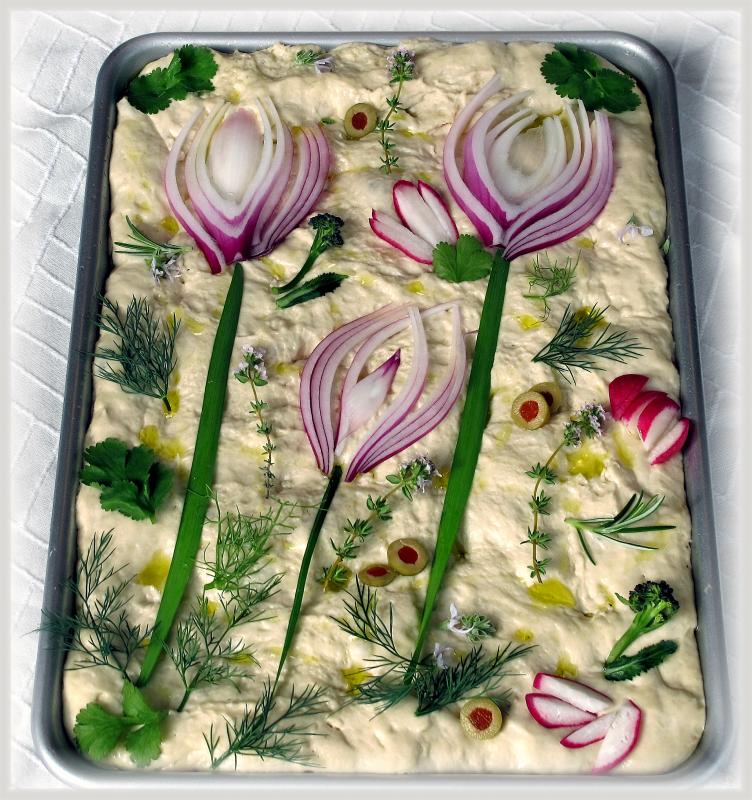
Inspiration for this week’s column came from an image I stumbled across online. Most of the articles and posts referred to it as “Focaccia Flower Bread” or “Focaccia Bread Art” and featured pictures of the rectangular bread covered with decorative floral designs created with vegetables, herbs and garnishes. With over a million hits, there are almost as many variations.
Focaccia is described as a “flat bread,” which is a bit of misnomer, as it does incorporate yeast as a leavening agent. Its interior texture is quite tender, while the top and bottom crusts are crunchy due to the olive oil in the recipe. Food historians believe it originated with the Etruscans during the first century BC in what is now North Central Italy.
The name comes from the Roman phrase “panis focacius” which translates to “hearth bread” and likely refers to a rough dough baked in the coals. The early ingredients in focaccia have not changed much – flour, olive oil, water and yeast. Traditionally, the rather plain loaf was torn into pieces and used to sop up the broth in salty soups.
As the Romans expanded their empire into France and Spain, focaccia developed regional signatures. For example, Spanish pan de hogaza doesn’t mix olive oil into the dough, but instead brushes the baked loaf with it. In certain regions of France you’ll find fugasse, which adds finely minced red bell pepper, onion and cheddar cheese to the rustic loaf.
Over time, focaccia became more flavorful with the addition of herbs and spices, both mixed in and scattered atop the loaves. Most commonly seen are rosemary and sage, while there are also sweet varieties made with honey, raisins and lemon peel. For the focaccia in the photo, we focused on what is on the bread, rather than mixing anything into the dough.
The basic focaccia recipe comes together quickly in a stand mixer fitted with a dough hook. Once the yeast is proofed and bubbly, the dough is mixed from the addition of water, flour, salt and olive oil. Once the soft dough has come together, it’s transferred to a warm corner of the kitchen to double in size, then allowed to rest overnight in the refrigerator before adding decorations and baking. Although the recipe includes a number of steps, there’s no kneading required for this bread.
To create a floral design, start with red onions, thinly sliced to resemble flower petals, and set them at the end of chive stalks for stems. Scatter feathery wisps of fennel and dill to add frills, sliced olive for some salty savor, radishes for color, and sprigs of thyme and rosemary complete with blossoms to bring “real” flowers.
This photo was taken before baking so you could see the ingredients. After a half-hour in the oven, the onions and radishes softened, broccolini roasted and the entire top crust took on a golden brown sheen (thanks to the generous drizzle of olive oil). No need for parchment paper, as there’s olive oil spread in the bottom of the pan before adding the dough.
You can find all sorts of ideas on how to make “flowers,” such as miniature red bell pepper rings bunched around capers, or thin slices of yellow bell peppers forming the petals of a sunflower with chopped black olives for the center. Parsley, sage and basil all work well for leaves, and chives or green onions can become flower stems.
To enjoy the texture of focaccia bread, it is best eaten the same day it is baked, and especially delicious still warm from the oven. You can reheat the bread at 350 F for 5 or 10 minutes to regain that distinctive chewiness. Focaccia can also be used as sandwich bread by slicing through the loaf horizontally. I’ve included a basic focaccia recipe and encourage you to let your imagination help you create floral decorations.
Focaccia Flower Bread
2 C warm water
1 T sugar
1 package dry yeast
1/4 C olive oil
1 t salt
5 C flour
1/3 C olive oil, separated
1 T flaky salt
vegetables and herbs for topping
Combine 1 C water, sugar and yeast in the bowl of a stand mixer. Whisk to combine and allow to proof for 5 minutes. When mixture is frothy and bubbling, fit the mixer with a bread hook. Add 1 C flour and mix on low until combined. Add remaining 1 C water, 1/4 C olive oil, salt and 2 C flour; mix on low until combined. Gradually add remaining 2 C flour and continue mixing on low. When dough begins to pull away from the sides of the bowl, test to see if it bounces back when poked. If not, continue mixing another 2 minutes. Add 2 T olive oil to a large bowl. Place rounded ball of dough in the bowl and turn so it is covered with oil on all sides. Cover with a clean dish towel and set in a warm place to rise until doubled in size, about 2 hours. Coat the bottom of a 12-by-17-inch sheet pan with 2 T olive oil and stretch dough to reach all the sides of the pan. Cover with plastic wrap and refrigerate overnight. When ready to bake, remove the pan from the refrigerator and allow to warm for about 30 minutes; preheat oven to 450 F. When dough is ready to bake, use your fingers to make dimples across the top. Sprinkle with flaky salt and drizzle generously with olive oil. Arrange vegetables and herbs into a decorative floral design. Bake until golden, about 20 minutes.
"bread" - Google News
May 14, 2021 at 09:17PM
https://ift.tt/3hsL2lE
Focaccia flower bread invites creativity into basic recipe - CapeGazette.com
"bread" - Google News
https://ift.tt/2pGzbrj
https://ift.tt/2Wle22m
Bagikan Berita Ini














0 Response to "Focaccia flower bread invites creativity into basic recipe - CapeGazette.com"
Post a Comment